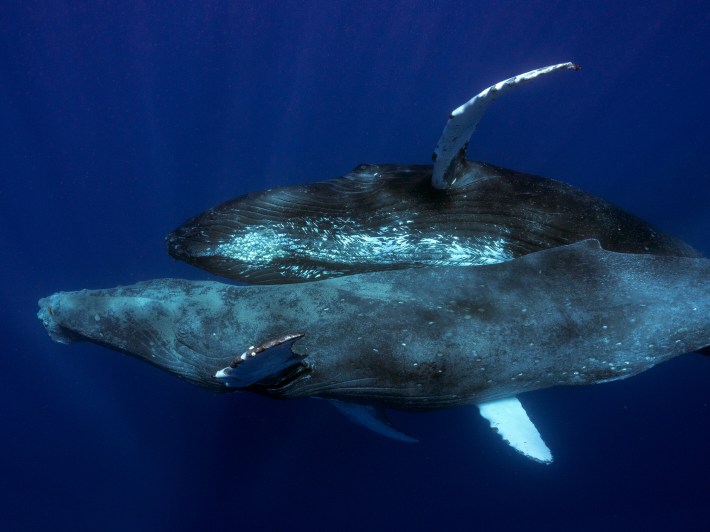On Jan. 19, 2022, Lyle Krannichfeld and Brandi Romano were boating off the island of Maui when they encountered two humpback whales close to the surface. As the whales slowly approached their boat, the photographers observed one whale was an unusual brown color. They shut off the engines, held their cameras off the side of the boat, and photographed the whales as they circled the boat for about 30 minutes. They observed the larger whale repeatedly swimming up to the brown whale and engaging in brief, shallow penetration. Their cinematic photos reveal the two whales entangled with each other against a backdrop of the gauzy film of sunlight, the white spray of waves, and the deep blue of the open ocean.
On Feb. 27, the journal of Marine Mammal Science published these photos, which marked the first-ever observation of humpback whales copulating, in a paper. But the observation had a twist—the whales were males. People rejoiced, and gay whale content abounded. "Free willy!" exclaimed the Daily Mail. "Moby Dick!" said many people, probably. At a glance, this was a feel-good story for the gays, the whales, and the gay whales—another observation to add to science's long but still-growing list of more than 1,500 animals that engage in sexual behavior with others of the same sex. "It is not surprising that humpback whales engage in male-male sexual behavior, as we know this to occur in many other species of cetaceans," said Stephanie Stack, an author on the paper and a researcher at the nonprofit Pacific Whale Foundation.
A closer read of the paper, however, reveals this particular act of whale sex was not a serendipitous tryst between two strapping and eager males in the peak of health, but rather a more complicated encounter between a healthy whale and a much weaker one. The brown whale was clearly emaciated and peppered with whale lice, parasitic crustaceans whose populations can proliferate on sick or injured whales. The researchers identified both whales as adult males because the cetaceans had been registered in the Pacific Whale Foundation's photo ID catalog. When the researchers reviewed the photographs, they realized the brown whale had a significant jaw injury that would have prevented him from feeding normally. The authors could not determine a specific cause of the injury, but noted ship strikes can break bones in large whales. "Unfortunately, these injuries are not always immediately lethal, and the animal can suffer for weeks or months before succumbing to its injuries," the authors write. The brown whale's emaciated body and skin condition suggest he had been in poor health for some time and may have been dying.
The injured brown whale was swimming in slow circles around the boat in an attempt to escape the other whale, but he appeared to be too slow to stave off the encounter. The large, healthy whale penetrated the brown whale while holding him with his pectoral fins, a grasping behavior that has been previously described in humpback mating. The researchers also cited a 1998 paper that observed a humpback whale holding its pectoral fins around a dead male whale and extruding its penis. The researchers suggested that the brown whale's S-shaped posture, which has been observed in whales facing threatening interactions, could indicate the penetration was unwanted.

Without an ability to interview either of the involved parties, it is impossible to conclude what this encounter meant for either whale. Maybe the healthy whale wanted to strengthen a relationship with a companion, or maybe he wanted to show dominance over an injured competitor. "I hesitate to speculate too much on the motivations of the whales involved and what would have happened if they were both healthy whales, or two different sexes," Stack said.
For a long time, evolutionary biologists have attempted to understand what they framed as the "evolutionary paradox" of same-sex sexual behavior, or why animals across so many lineages penetrate, mount, sing to, rub against, and lick each other without any obvious benefit to their survival or the creation of more offspring. But in a perspective published in Nature Ecology & Evolution in 2019, a group of researchers offered a new hypothesis, which pushes back against the idea that same-sex sexual behavior is a paradox in the first place. Instead of asking why animals do this, the researchers posed a new question: Why not?
Framing same-sex sexual behavior as a conundrum is based on several nonscientific, heteronormative assumptions, as the authors explain in a blog for Scientific American. The first assumption is that this behavior is costly, meaning it wastes significant time, energy, and resources that an animal could instead spend on improving its fitness or producing offspring. But sexual behavior between different sexes can also be costly, as mating does not always produce offspring. The second assumption stems from the fact most of the scientists who study same-sex behavior in animals focus on a single species, perhaps the species they already study. This focus suggests that same-sex sexual behavior evolved independently in that species. But when a certain behavior is observed in so many animal lineages, scientists often raise the evolutionary possibility that it evolved from a common ancestor. Why should same-sex sexual behavior be treated any different?
By this hypothesis, perhaps same-sex sexual behavior has been happening on Earth since the very first sex happened between animals. The most likely scenario, the authors argue, is that the first sexually reproducing animals mated indiscriminately with whomever they found. How would they have been able to tell another's sex in the first place? Physical differences and other distinguishing traits between sexes would not have evolved before sexual behavior. Moreover, this kind of anything-goes approach to mating has benefits, as it takes less brainpower to recognize one kind of mate from another.

Ultimately, the researchers call on other biologists to stop dismissing same-sex sexual behavior as something that is abnormal or even mutually exclusive from sexual behavior with different or opposite sexes. A better way to think about it all would be to acknowledge that individual animals and populations can have many kinds of sexual encounters, same-sex and otherwise, in "the messy and tangled spectrum of behaviours, traits and strategies we clumsily refer to as ‘sex’ and ‘sexual behaviour’," the authors write.
To bring it all back to the humping of the humpbacks, this perspective helps contextualize the two male whales' rendezvous. The Nature Ecology & Evolution authors point out that same-sex sexual behaviors are often categorized as aggression, displays of dominance or social bonding, and therefore separated from "regular" sexual behavior. Hawai'i is a breeding ground for humpbacks, where males often expend energy competing against each other to get closer to a female, Stack said. "This is a type of aggression between male whales and may have extended into what we observed," she added. But aggressive, dominant, or social dynamics can also be present in sexual behavior between different sexes, the perspective's authors note.
What have we learned from all of this? Humpbacks have officially joined the list of marine mammals that engage in same-sex sexual behavior: walruses, gray seals, Amazon river dolphins, common bottlenose dolphins, Atlantic spotted dolphins, killer whales, gray whales, and bowhead whales. This list, like the list of all biologically queer animals, is likely a vast underestimate. Many such observations have gone unreported because researchers found the behaviors shameful or irrelevant to their own research. And many more observations of animal mating are simply assumed to be between different sexes because some researchers perceive the mating behavior as an indicator of the individuals' opposite sexes. So it is likely that there are more species of whales doing all sorts of sexual things with other whales of all sexes. I hope this context brings you a little peace in thinking about the two male whales who shared a brief and seemingly fraught act of penetration. And I hope the whales are at peace, wherever they are.






